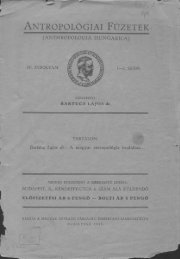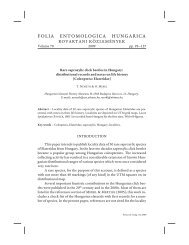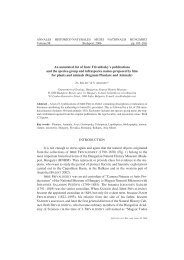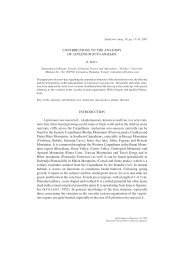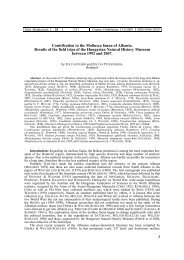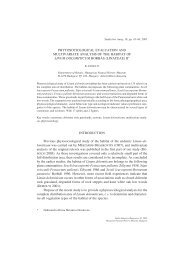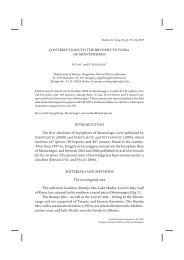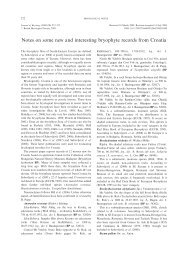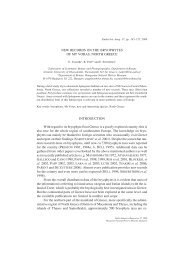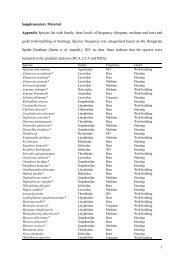Create successful ePaper yourself
Turn your PDF publications into a flip-book with our unique Google optimized e-Paper software.
Click beetles of Taiwan collected by the expeditions of HNHM (Coleoptera: Elateridae) 71Sericus (Shirozulus) formosanus (OHIRA, 1966)Shirozulus formosanus OHIRA, 1966b: 271.Sericus (Shirozulus) formosanus (OHIRA, 1966): SUZUKI 1999: 195.Material examimed – 1 female. Taiwan: Nantou County, Kao-Leng Dyi, 18 km W ofWushe, 24°4.561’N, 121°8.046’E, 1945 m, swept from vegetation, 18–19.IV.2002, D. A. ANSTINE,GY.FÁBIÁN &O.MERKL.Mulsanteus peregovitsi sp. n.(Figs 25–27)Material exam<strong>in</strong>ed – Holotype male: Taiwan: Ilan County, Fu Shan Botanical Garden,700 m, swept from vegetation, 8–11.IV.2002, O. MERKL (HNHM). – 1 Paratype male: NantouCounty, 6 km E of Wushe, 24°01’82”N, 121°10’65”E, 1300 m, 21.IV.1997, L. PEREGOVITS &A.KUN (CPG).Description – Male. Moderately sh<strong>in</strong>y; dark brown with antennae, palps and legs lighter,ferrug<strong>in</strong>ous; covered with fulvous vestiture, semierect on the body, erect on antennomeres (Fig. 25).Head with eyes as wide as the anterior marg<strong>in</strong> of pronotum; frons convex to flat at anteriormarg<strong>in</strong>, the latter complete and straight; punctures coarse, umbilicate and contiguous. Antennae(Fig. 26) exceed<strong>in</strong>g h<strong>in</strong>d angles of pronotum by three antennomeres; second and thirdantennomeres globous, broader than long, the third obliquely truncate; second and third, takentogether, much shorter than fourth; fourth to tenth antennomeres strongly serrate, sublamellate,at apex emarg<strong>in</strong>ate; fourth to sixth just longer than wide; seventh to tenth slender and more elongate;eleventh longer than penultimate, subellipsoidal. Pronotum as long as broad, widest atposterior angles; strongly convex, at base vertically, at sides abruptly slop<strong>in</strong>g; sides from base toanterior marg<strong>in</strong> regularly narrow<strong>in</strong>g; posterior angles elongate, acum<strong>in</strong>ate, a little convergent atapex with a car<strong>in</strong>a well dist<strong>in</strong>ct and directed <strong>in</strong>side; punctation uniform on whole surface; puncturessuboval, vaguely umbilicate, nearly contigous. Scutellum tongue-shaped, flat, denselypunctate. Elytra slightly narrower than pronotum across h<strong>in</strong>d angles, 2.6–2.7 times longer thanthe latter; sides regularly and notably narrow<strong>in</strong>g from base to apex, the latter truncate; striae wellmarked and punctured; <strong>in</strong>terstriae flat, roughly punctured. Prosternal process scarcely emarg<strong>in</strong>ateat apex. Male genitalia as <strong>in</strong> Fig. 27 (length mm 1.5). Size. Length 11.7–13 (holotype) mm;width: 3–3.1 (holotype) mm.Female unknown.Etymology – This species id dedicated to one of its collectors, the lepidopterist Mr.LÁSZLÓ PEREGOVITS (HNHM), study<strong>in</strong>g biogeography of Eastern Asia, <strong>in</strong>sect conservationand population biology of <strong>in</strong>sects.Comparative remarks – The new species is similar to Mulsanteus junior(CANDÈZE, 1873) from Japan because of the general shape and size, but can beseparated by the sublamellate antennomeres and truncate apex of elytra.Annls hist.-nat. Mus. natn. hung. 99, 2007



